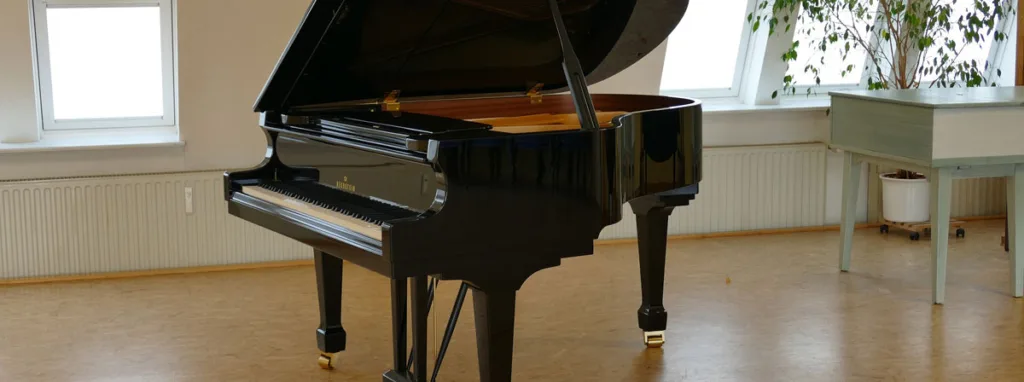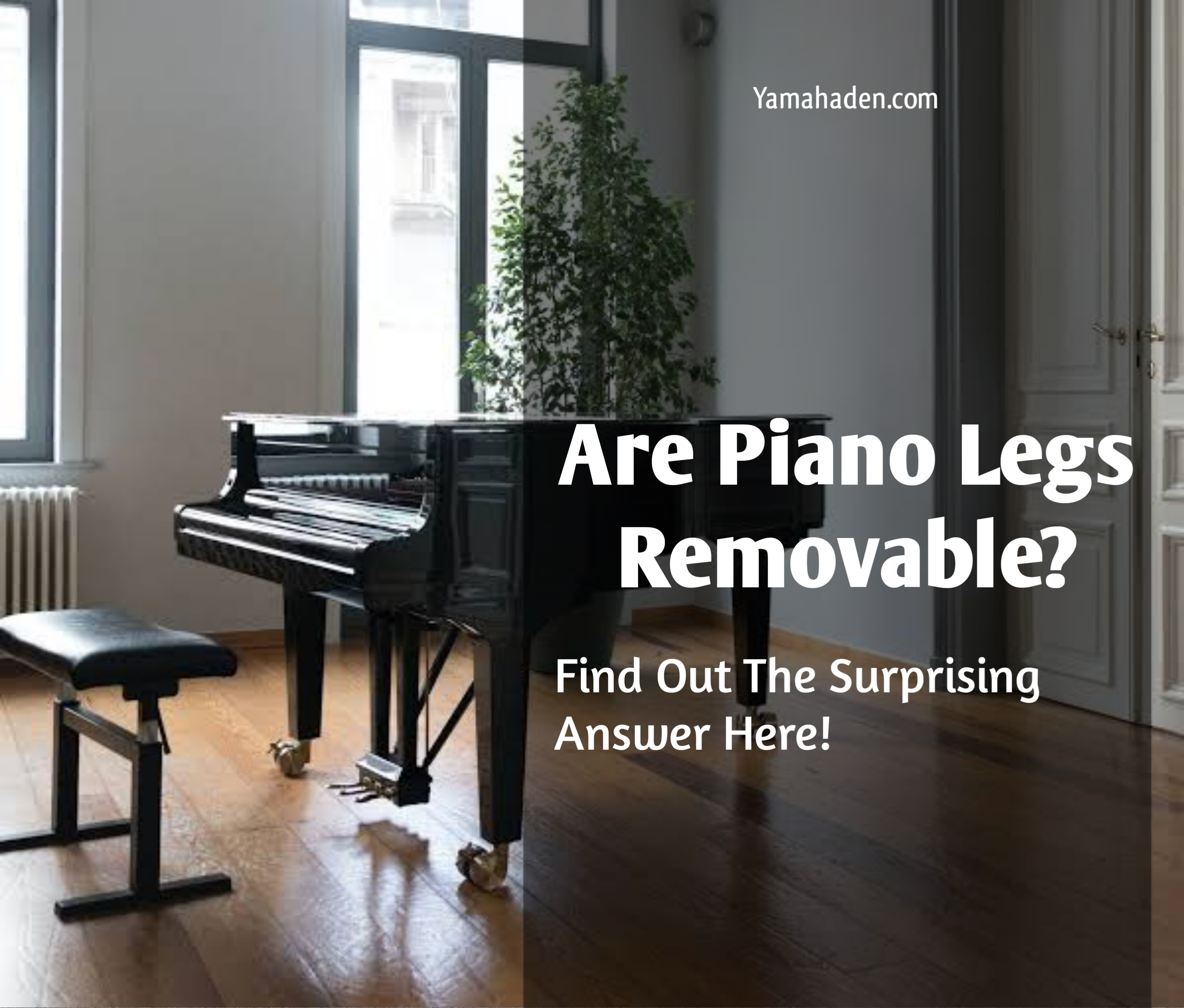One of the most common questions asked by beginner piano players is “are piano legs removable?” And it’s easy to see why this question might come up- after all, pianos are heavy and bulky instruments, and being able to remove the legs would make transportation and storage much easier.
But what about those who are looking to replace a damaged leg or change the overall look of their piano? Can they simply unscrew the legs and swap them out? In this article, we’ll delve into the surprising answer to this question, covering everything from how piano legs are attached in the first place to whether or not they can be removed without causing any damage. So if you’ve been wondering whether your piano’s legs are detachable, keep reading to find out!
So, Are piano legs removable??
Piano legs are removable! This may come as a surprise to some, but most pianos are designed with detachable legs for easier transportation and storage. The process of removing the legs varies depending on the type and model of piano, but it typically involves unscrewing bolts or using a lever mechanism. Some portable pianos even have foldable or collapsible legs for added convenience. So if you ever need to move your piano from one room to another or transport it to a new location, rest assured that its legs can be easily removed for a smoother transition.
Understanding How Piano Legs are Attached
When you look at a piano, it’s easy to overlook the intricacies that hold this majestic instrument together. The legs, for instance, are not just aesthetically pleasing but also structurally significant. They are usually attached using robust brackets and bolts for grand pianos or screws in upright models. These components ensure the piano’s weight is evenly distributed, safeguarding both the instrument and your floor.
Installing or replacing these legs requires precision. First, you’ll find metal plates or brackets on each corner of where the legs attach. These plates have pre-drilled holes that align with corresponding holes on the leg itself. Bolts pass through them to secure everything tightly—sometimes accompanied by washers for added stability.
Grand pianos often come with detachable legs to facilitate transport; upright models operate differently due to their smaller profile and weight distribution mechanics:
- Detachable Legs: Found mostly in grand pianos; easier disassembly.
- Permanently Fixed Legs: Common in uprights; screwed directly into place.
Understanding how these parts fit allows owners both novice and experienced alike to perform simple maintenance checks without requiring professional help constantly.
So next time you’re near a piano, take a moment to appreciate those gracefully poised legs—they do more than just stand there elegantly!
Exploring the Different Types of Pianos and Their Leg Structures
Pianos come in all shapes and sizes, each with its own unique charm. From the majestic grand pianos to the upright ones you’d find in a cozy living room, there’s something magical about these instruments. Grand pianos stand out not only for their impressive sound but also for their elegant leg structures. These legs are often beautifully carved and can include intricate details such as claw feet or spiral designs. The legs aren’t just there for show either; they provide crucial support for the piano’s heavy frame and strings.
Upright pianos, though more compact, still boast some interesting leg styles. You might notice squared-off legs that give a sturdy feel or perhaps tapered legs that add a bit of finesse to your décor. Spinets, consoles, studios—even these smaller versions have leg styles worthy of attention! Some modern uprights even offer sleek metal frames instead of traditional wood, giving them a contemporary twist. Whether you’re drawn to classic elegance or modern flair, exploring different piano types opens up a world filled with aesthetic delights alongside musical wonders.
– Grand Pianos:
– Intricate carvings
– Claw feet
– Spiral designs
– Upright Pianos:
– Squared-off legs
– Tapered designs
– Metal frames
Every choice offers its own beautiful blend of form and function that’s hard to resist.
Read also: Are piano legs removable?
The Process Involved in Removing Piano Legs
Taking apart a piano can seem daunting, but with the right steps, it’s manageable. Start by preparing your workspace. Make sure you have enough room and good lighting. Gather all necessary tools: screwdrivers, a wrench set, and some blankets or padding to protect the floor and the piano itself. The first step is to position the piano on its side carefully; this minimizes strain on your body and reduces risk of damage.
Once in place, locate where each leg connects to the main body of the piano. Typically, pianos have three legs: one at each end of the keyboard and one supporting the back area near the pedals. Begin with unscrewing any bolts or screws securing these legs:
- For front legs – Look for brackets that might be holding them.
- Back leg – Often screwed directly into a metal plate; you’ll need a sturdy screwdriver.
After unscrewing all parts completely, gently wiggle each leg until it comes free. Remember that patience is key here—forcing it may cause unnecessary harm.
Lastly, safely wrap up those removed legs using blankets or bubble wrap for transport or storage purposes! This process ensures everything remains intact for future use while keeping your space organized and safe from accidental trips over displaced parts.

Potential Risks and Damages Associated with Removing Piano Legs
Taking the legs off a piano might seem straightforward, but it can be surprisingly tricky. One major risk involves harming the delicate wood and finish of the instrument. Pianos are often made of fine woods like mahogany or walnut, which can get scratched or dented if not handled with utmost care. Even tiny nicks can diminish both its beauty and value. There’s also potential harm to the tuning mechanisms inside, as any rough movement could knock them out of alignment.
Then there’s the matter of safety for those doing the job. Removing piano legs requires physical strength and precise coordination, since pianos are heavy – some weigh over 500 pounds! Incorrect handling could lead to severe back injuries or worse if a leg buckles unexpectedly during lifting. To avoid these risks:
- Use proper tools designed specifically for this task.
- Always have multiple people assist in lifting and moving.
- Cushion areas where parts might come into contact with hard surfaces.
By following these tips, you can help ensure everything goes smoothly without causing damage—or injury—along the way.
You may also like: how often should a piano be tuned
Conclusion: To Remove or Not to Remove – Making an Informed Decision
Choosing whether to remove or keep a tree in your yard can feel like an overwhelming decision. Trees offer shade, beauty, and even increase property value. But sometimes, they pose risks that outweigh the benefits. Dead branches falling during storms can cause damage or injury, and roots might disrupt pipelines or sidewalks. Understanding when removal is necessary involves looking at several factors closely.
First off, assess the health of the tree. Is it diseased beyond recovery? Next, think about its location — is it too close to your home or power lines? Then consider any potential hazards; for example:
– Can strong winds easily knock it down?
– Do the roots threaten underground utilities?
Finally comes personal preference: Does this tree enhance your outdoor space?
Talking with an arborist usually helps clarify these points since they provide expert guidance.
In conclusion:
To Remove or Not to Remove – Making an Informed Decision
Balancing safety concerns with environmental contributions makes this choice complex yet vital.
You have options! Either way you go has lasting impacts on both your property’s look and safety.

